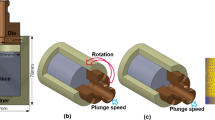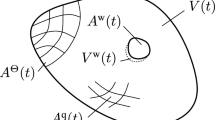Abstract
The manufacturing of aluminium alloy structural aerospace parts involves multiple steps, the principal ones being the forming (rolling, forging etc.), the heat treatments and the machining. During this last step, the final geometry of the part is obtained. Before machining, the workpiece has therefore undergone several manufacturing steps resulting in unequal plastic deformation and metallurgical changes which are both sources of residual stresses. On large and complex aluminium alloy aeronautical parts, up to 90 % of the initial workpiece volume can be removed by machining. During machining, the mechanical equilibrium of the part is in constant evolution due to the redistribution of the initial residual stresses.The residual stress redistribution is the main cause of workpiece deflections during machining as well as of post-machining distortion (after unclamping). Both can lead to the non-conformity of the part with the geometrical and dimensional tolerance specifications and therefore to a rejection of the part or to additional conforming steps. In order to improve the machining accuracy and the robustness of the process, the effect of the residual stresses has to be considered for the definition of the machining process plan. In this paper, a specific numerical tool [2] allowing to predict workpiece deflections during machining and post-machining distortion is used to study the influence of the machining sequence on the machining quality in taking into consideration the initial residual stresses. A first machining process plan defined as the reference case is simulated. Simulation results are then compared with experimental ones showing the feasibility to use the developed tool to predict the machining quality depending on the initial residual stresses, the fixture layout and the machining sequence. Using the computational tool, a method to optimise the machining quality depending on the initial workpiece and on the machining sequence is presented. A machining process plan allowing to respect the tolerance specifications is then defined. This demonstrates the feasibility to adapt and to optimise the machining process plan to ensure conformity of the part with the tolerance specifications.
Similar content being viewed by others
References
Asante J (2008) A combined contact elasticity and finite element-based model for contact load and pressure distribution calculation in a frictional workpiece-fixture system. Int J Adv Manuf Technol 39(5–6):578–588. doi:10.1007/s00170-007-1187-5
Cerutti X, Mocellin K (2014) Parallel finite element tool to predict distortion induced by initial residual stresses during machining of aeronautical parts. Int J Mater Form 8(2):255–268. doi:10.1007/s12289-014-1164-0
Das S, Chandra U (1999) Residual stress and distortion. In: Totten GE, Mackenzie DS (eds) Handbook of aluminum metallurgy: processes and equipment, vol 1. Marcel Dekker, Inc. , New York
De Meter E (1995) Min-max load model for optimizing machining fixture performance. J Eng Ind 117(2):186–193
Denkena B, Leon LD (2009) Milling induced residual stresses in structural parts out of forged aluminium alloys. Int J Mach Mach Mater 4(4):335–344. doi:10.1504/IJMMM.2008.023717
Jeanmart P, Bouvaist J (1985) Finite element calculation and measurement of thermal stresses in quenched plates of high—strength 7075 aluminium alloy. Mater Sci Technol 1(10):765–769
Lequeu P, Lassince P, Warner T, Raynaud GM (2010) Engineering for the future: weight saving and cost reduction initiatives. Aircr Eng Aerosp Technol 73:147–159
Lequeu P, Smith K, Danielou A (2010) Aluminum-copper-lithium alloy 2050 developed for medium to thick plate. J Mater Eng Perform 19(6):841–847
Li B, Melkote SN (1999) Improved workpiece location accuracy through fixture layout optimization. Int J Mach Tools Manuf 39(6):871–883. doi:10.1016/S0890-6955(98)00072-8
Ma K, Goetz R, Svrivatsa S (2010) Modeling of residual stress and machining distortion in aerospace components. ASM Handbook, Metals Process Simul 22B:386–407
Rai JK, Xirouchakis P (2008) Finite element method based machining simulation environment for analyzing part errors induced during milling of thin-walled components. Int J Mach Tools Manuf 48(6):629–643
Satyanarayana S, Melkote S (2004) Finite element modeling of fixture-workpiece contacts: single contact modeling and experimental verification. Int J Mach Tools Manuf 44(9):903–913. doi:10.1016/j.ijmachtools.2004.02.010
Sim W (2010) Challenges of residual stress and part distortion in the civil airframe industry. Int J Microstruct Mater Prop 5:446–455
Tandon R, Green DJ (1990) Residual stress determination using strain gage measurements. J Am Ceram Soc 73(9):2628–2633
Tang ZT, Liu ZQ, Ai X (2007) Optimization of bulkhead processing sequence for multi-frame monolithic components by fem. Adv Mater Res 24–25:355–360
Virkar AV (1990) Determination of residual stress profile using a strain gage technique. J Am Ceram Soc 73(7):2100–2102
Wang SP, Padmanaban S (2004) A new approach for fem simulation of nc machining processes. AIP Conf Proc 712(1):1371–1376. doi:10.1063/1.1766720
Wei Y, Wang X (2007) Computer simulation and experimental study of machining deflection due to original residual stress of aerospace thin-walled parts. Int J Adv Manuf Technol 33(3–4):260–265. doi:10.1007/s00170-006-0470-1
Yang Y, Li M, Li K (2013) Comparison and analysis of main effect elements of machining distortion for aluminum alloy and titanium alloy aircraft monolithic component. Int J Adv Manuf Technol 1–9. doi:10.1007/s00170-013-5431-x
Author information
Authors and Affiliations
Corresponding author
Rights and permissions
About this article
Cite this article
Cerutti, X., Mocellin, K. Influence of the machining sequence on the residual stress redistribution and machining quality: analysis and improvement using numerical simulations. Int J Adv Manuf Technol 83, 489–503 (2016). https://doi.org/10.1007/s00170-015-7521-4
Received:
Accepted:
Published:
Issue Date:
DOI: https://doi.org/10.1007/s00170-015-7521-4




